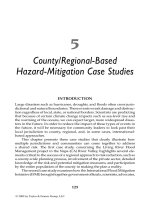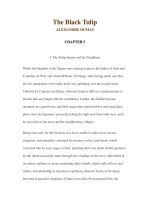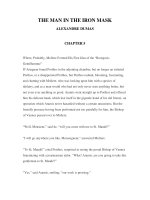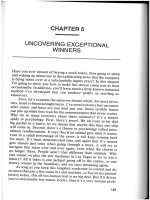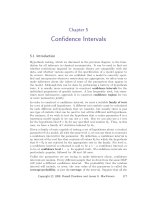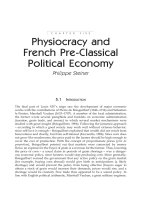Mercury Hazards to Living Organisms - Chapter 5 ppsx
Bạn đang xem bản rút gọn của tài liệu. Xem và tải ngay bản đầy đủ của tài liệu tại đây (190.97 KB, 14 trang )
P
ART
2
Mercury Concentrations in Field Collections
of Abiotic Materials, Plants, and Animals
© 2006 by Taylor & Francis Group, LLC
47
C
HAPTER
5
Mercury Concentrations in Abiotic Materials
Mercury burdens in sediments and other nonbiological materials are estimated to have increased
up to five times prehuman levels, primarily as a result of anthropogenic activities (USNAS, 1978).
Maximum increases are reported in freshwater and estuarine sediments and in freshwater lakes and
rivers, but estimated increases in oceanic waters and terrestrial soils have been negligible (USNAS,
1978). Methylmercury accounts for a comparatively small fraction of the total mercury found in
sediments, surface waters, and sediment interstitial waters of Poplar Creek, Tennessee, which was
initially contaminated with mercury in the 1950s and 1960s. Mercury measurements in Poplar
Creek from 1993 to 1994 showed that methylmercury accounted for 0.01% of the total mercury
in sediments, 0.1% in surface waters, and 0.3% in sediment interstitial waters (Campbell et al.,
1998). The residence time of mercury in nonbiological materials is variable, and depends on a
number of physicochemical conditions. Estimated half-time residence values for mercury are 11 days
in the atmosphere, 1000 years in terrestrial soils, 2100 to 3200 years in ocean waters, and more
than 250 million years in oceanic sediments (USNAS, 1978; Boudou and Ribeyre, 1983; Clarkson
et al., 1984); however, this estimate was only 1 month to 5 years for water from the contaminated
Saguenay River in Quebec (Smith and Loring, 1981).
This chapter documents mercury concentrations in air, coal, pelagic clays, sediments, sewage
sludge, snow, soils, suspended particulate matter, seawater, freshwater, groundwater, and sediment
interstitial waters from selected geographic locales.
5.1 AIR
Most (up to 59.1%) of the mercury contributed to the atmosphere each year is from anthropogenic
sources such as combustion of fossil fuels from power plants, with natural sources such as oceans,
land runoff, and volcanoes contributing almost all the remainder (Table 5.1).
Atmospheric concentrations of total mercury in the northern hemisphere are about three times
higher than those sampled in the southern hemisphere owing to greater sources from human
activities in the comparatively industrialized and populated north (Lamborg et al., 1999). Different
mercury species are dominant at different Japanese locations. For example, in 1977 to 1978, Hg
2+
was the dominant species in air over hot springs, volcanoes, and urban centers; however, Hg
o
was
dominant in air over chloralkali plants and rural areas (Takizawa et al., 1981; Table 5.2). Enrichment
of toxic metals in respirable particulate matter emissions from a coal-fired power plant in Central
India is documented, especially for mercury that was enriched 4.8 times over the coal (Sharma and
Pervez, 2004; Table 5.2).
© 2006 by Taylor & Francis Group, LLC
48 MERCURY HAZARDS TO LIVING ORGANISMS
© 2006 by Taylor & Francis Group, LLC
Table 5.1 Contributions to Atmospheric Mercury from Natural and Anthropogenic Sources
Source
(% of total)
a
Mercury
Concentration
or Emission
Estimated Amount of Mercury
Discharged into Global
Atmosphere per Year
(metric tons) Ref.
b
Volcanoes (1.0–1.4) 28.0–1400.0 ng/m
3
60 1–3
Land (16.7–22.7) 1.0–6.0 ng/m
3
1000 2, 4, 5
Mines (0.2–2.3) 1.0–5000.0 ng/m
3
10–100 4, 6–9
Oceans (13.3–45.4) 1.0–3.0 ng/m
3
800–2000 5, 10
Anthropogenic (33.3–59.1) 10.0–900.0 kg/year
c
2000–2600 5, 10, 11
a
The estimated total amount of mercury contributed to the atmosphere worldwide ranges between 4400
and 6000 metric tons annually; mercury concentrations in the atmosphere usually range between 1.0
and 2.0 ng/m
3
(Porcella, 1994; Lamborg et al., 2000; Gray, 2003).
b
Reference: 1, Fitzgerald, 1989; 2, Varekamp and Buseck, 1986; 3, Ferrara et al., 1994; 4, Gustin et al.,
1994; 5, Mason et al., 1994; 6, Ferrara et al., 1991; 7, Ferrara et al., 1998; 8, Gustin et al., 1996; 9,
Gustin et al., 2000; 10, Lamborg et al., 2000; 11, USEPA, 2000.
c
Range of mercury emissions from power plants in the United States (USEPA, 2000).
Table 5.2 Mercury Concentrations in Selected Abiotic Materials
Material (units) Concentration Ref.
a
Air (ng/m
3
)
Atmosphere over open ocean; total mercury:
Southern hemisphere, 60
°S 1.0 25
Northern hemisphere 3.0 25
India; near a large coal-fired power station:
Respirable suspended particulate matter 50.0 31
Nonrespirable suspended particulate matter 30.0 31
Flyash 28.0 31
Japan:
Remote areas < 5.0–20.0 12
Urban areas 85.0–100.0 12
Japan; 1977–1978; maximum values:
Over open volcanoes (southern Japan) vs. over hot
springs (northern Japan):
Particulate mercury 2.0 vs. 1.0 27, 29
Hg
2+
368.0 vs. 126.0 29
CH
3
Hg
+
19.0 vs. 9.0 27, 29
Hg
o
97.0 vs. 21.0 29
(CH
3
)
2
Hg 9.0 vs. 5.0 29
Urban vs. rural:
Particulate mercury 0.0 vs. 1.0 27
Hg
2+
44.0 vs. 33.0 27
CH
3
Hg
+
38.0 vs. 8.0 27
Hg
o
10.0 vs. 30.0 27
(CH
3
)
2
Hg 5.0 vs. 6.0 27
Over chloralkali plant:
Particulate mercury 0.0 27
Hg
2+
80.0 27, 29
CH
3
Hg
+
34.0 27
Hg
o
61.0 27
(CH
3
)
2
Hg 17.0 27
Siberia, 1992–1993; summer vs. winter:
Gaseous 0.7–2.3 vs. 1.2–6.1 14
Particulate 0.005–0.02 vs. 0.02–0.09 14
MERCURY CONCENTRATIONS IN ABIOTIC MATERIALS 49
© 2006 by Taylor & Francis Group, LLC
Material (units) Concentration Ref.
a
Coal (mg/kg dry weight = DW)
Bituminous 0.07 10
Lignite 0.12 10
Sub-bituminous 0.03 10
Various mean 0.2; rarely >1.0 33
Pelagic Clays (mg/kg fresh weight)
430 km southeast of San Diego, CA 0.39 18
Rock (
µg/kg DW)
Limestone, Pennsylvania 9.0 (4.0–14.0) 36
Shale, eastern Canada 42.0 37
Sediments, Mercury-Contaminated Areas (mg/kg DW)
Near chloralkali plant:
Quebec, Canada 12.0 3
Norway 250.0 (90.0–350.0) 4
Thailand 8.0–58.0 5
Near gold mining operations
b
:
South Dakota 0.1–4.1 6
Australia 120.0 7
Ecuador (cyanide extraction facility); 1988; dry season 0.1–5.8
c
28
Near mercury-fungicide plant:
Denmark 22.0 8
Near offshore oil fields:
Southeastern Brazil; 1998–1999 vs. reference
locations
0.036–0.047 (0.013–0.08) vs.
0.01–0.05
21
Near acetaldehyde plant:
Minamata Bay, Japan
b
28.0–713.0 4
Near pulp and paper mill:
Finland 746.0 9
Tennessee; Oak Ridge; 1993–1994; contaminated in
mid-1950s to early 1960s; methylmercury vs. total
mercury
Max. 0.012 vs. 0.6–140.0 15
Sediments, Uncontaminated Areas (mg/kg DW)
Adriatic Sea 0.13–1.5 17
Lakes 0.1–0.3 12
Marine 0.05–0.08 12
Rivers: < 0.05 12
North Central United States 0.02–0.06, max. 0.11 6
South Dakota 0.02–0.1 6
Thailand 0.03 5
Finland 0.02 5
Various lakes Usually < 10.0, frequently < 1.0 4
Wisconsin:
Deep precolonial strata 0.04–0.07 13
Top 15 cm 0.09–0.24 13
Sewage Sludge (mg/kg DW)
50 publicly owned treatment works (POTW), United
States
2.8 23
74 POTW, Missouri 3.9 (0.6–130.0) 23
(continued)
Table 5.2 (continued) Mercury Concentrations in Selected Abiotic Materials
50 MERCURY HAZARDS TO LIVING ORGANISMS
© 2006 by Taylor & Francis Group, LLC
Table 5.2 (continued) Mercury Concentrations in Selected Abiotic Materials
Material (units) Concentration Ref.
a
Snow (ng/L)
Arctic Alaska 1.5–7.5 35
Siberia, 1992—1993:
Total mercury 8.0–60.0 14
Methylmercury 0.1–0.25 14
Soils (
µg/kg DW)
Ribeiro Preto, Brazil; vicinity solid waste landfill site:
2002 vs. 2003 < 25.0 vs. 50.0 22
0–500 m from site vs. 200 m from site 50.0 (20.0–80.0) vs. 50.0 22
Critical limit for Brazilian agricultural soils < 2500.0 22
China; contaminated by mercury-containing wastewater
from acetaldehyde factory; about 135 tons of mercury
discharged into Zhuja River between 1970 and 2000:
Quingshen City; high contamination area vs. low
contamination area:
Total mercury 61,400.0, max. 329,900.0 vs.
7,000.0, max. 98,300.0
26
Methylmercury 45.0, max. 65.1 vs. 5.8, max. 43.6 26
Lanchong reference site:
Total mercury 110.0, max. 1780.0 26
Methylmercury 2.3, max. 7.0 26
Jakobstad, Finland:
Humus:
Rural 303.0 (116.0–393.0) 20
Urban 280.0 (150.0–1028.0) 20
Urban
Topsoil 93.0 (11.0–2,309.0) 20
Subsoil 44.0 (< 5.0–540.0) 20
Forest soils; total mercury vs. methylmercury:
Humus 100.0–250.0 vs. 0.2–0.5 24
Mineral horizon 15.0–30.0 vs. < 0.05 24
Jamaica; agricultural soils 221.0 (max. 830.0) 32
United Kingdom; near combustion plants; top soils
(0–15 cm) vs. subsurface soils (15–30 cm):
Coal-fired power plant with flue gas desulfurization
system (FGD):
Total Hg 297.0 vs. 86.0 16
Elemental Hg 95.0 vs. 64.0 16
Exchangeable Hg 2.0 vs. 1.0 16
Organic Hg 5.0 vs. 5.0 16
Hg sulfide 185.0 vs. 11.0 16
Residual Hg 10.0 vs. 4.0 16
Coal-fired power plant without FGD system:
Total Hg 495.0 vs. 135.0 16
Elemental Hg 193.0 vs. 107.0 16
Exchangeable Hg 2.0 vs. 3.0 16
Organic Hg 3.0 vs. 4.0 16
Hg sulfide 245.0 vs. 16.0 16
Residual Hg 51.0 vs. 4.0 16
Waste incinerator:
Total Hg 1470.0 vs. 2310.0 16
Elemental Hg 446.0 vs. 1950.0 16
Exchangeable Hg 9.0 vs. 3.0 16
Organic Hg 5.0 vs. 4.0 16
Hg sulfide 869.0 vs. 310.0 16
Residual Hg 136.0 vs. 33.0 16
MERCURY CONCENTRATIONS IN ABIOTIC MATERIALS 51
© 2006 by Taylor & Francis Group, LLC
Table 5.2 (continued) Mercury Concentrations in Selected Abiotic Materials
Material (units) Concentration Ref.
a
Crematorium:
Total Hg 392.0 vs. 680.0 16
Elemental Hg 193.0 vs. 480.0 16
Exchangeable Hg 5.0 vs. 3.0 16
Organic Hg 5.0 vs. 2.0 16
Hg sulfide 182.0 vs. 180.0 16
Residual Hg 6.0 vs. 14.0 16
Suspended Particulate Matter (mg/kg DW)
Germany, Elbe River, 1988, mercury-contaminated by
chloralkali plants:
Total mercury 30.0; max. 150.0 11
Methylmercury 2.7 11
Reference site, total mercury 0.4 11
Water (ng/L)
Coastal seawater < 20.0 2
Drainage water from mercury mines; California:
Total mercury 450,000.0 34
Methylmercury 70.0 34
Estuarine seawater < 50.0 2
Freshwater; Ecuador; near cyanide extraction gold
mining facility; 1988; dry season
2.2–1100.0
d
28
Freshwater, surface:
Arctic Canada 0.23–0.76 38
Arctic Russia 0.30–1.00 39
Finland 1.3–7.2 40
Lake Superior 0.49 41
High-altitude lakes, United States 1.07 42
Northern Minnesota 0.2–3.2 43
Glacial waters 10.0 2
Groundwater 50.0 2
Groundwater; southern Nevada; 190 km NW of
Las Vegas; Amaragosa Desert; Aug.–Sept. 2002:
Unfiltered 11.9 (0.4–36.7) 19
Filtered 5.4 (< 0.22–15.7) 19
Japan; Akita area; June–July 1978; maximum values
Rain
Total Hg 15.2 30
Inorganic Hg 14.3 30
Organic Hg 0.9 30
Lake water vs. river water
Total Hg 13.8 vs. 21.1 30
Inorganic Hg 8.8 vs. 9.0 30
Organic Hg 5.5 vs. 12.1 30
Lake water:
Siberia, Lake Baikal, summer 1992–1993:
Total mercury 0.14–0.77 14
Methylmercury max. 0.038 14
Sweden:
Total mercury 1.4–15.1 12
Methylmercury 0.04–0.8 12
United States:
Total mercury 0.4–10.7 12
Methylmercury 0.03–0.64 12
(continued)
52 MERCURY HAZARDS TO LIVING ORGANISMS
© 2006 by Taylor & Francis Group, LLC
In general, mercury concentrations were low in the atmosphere over the open ocean (1 to
3.0 ng/m
3
), up to 100.0 ng/m
3
in the air of large cities, and highest (495.0 ng/m
3
, 74.0% Hg
2+
) in
the atmosphere over open volcanoes (Table 5.2).
Table 5.2 (continued) Mercury Concentrations in Selected Abiotic Materials
Material (units) Concentration Ref.
a
Open ocean 5.3 (3.1–7.5) 1
Open ocean < 10.0 2
Rainwater:
Open ocean 1.0 2
Coastal ocean 10.0 2
Continents Often > 50.0 2
Siberia, 1992–1993:
Total mercury 3.0–20.0 14
Methylmercury 0.1–0.25 14
Sweden:
Total mercury 7.5–89.7 12
Methylmercury 0.04–0.6 12
Rivers and lakes 10.0, max. 50.0 2
River water:
Canada, Ottawa River:
Total mercury 4.6–9.8 12
Methylmercury 1.6–2.8 12
Japan:
Total mercury 19.3–25.9 12
Methylmercury 5.8–7.0 12
Siberia, 1992–1993:
Total mercury Max. 2.0 14
Methylmercury Max. 0.16 14
United States, Connecticut River:
Total mercury 45.0 12
Methylmercury 21.0 12
Seawater:
Japan:
Total mercury 3.2–12.5 12
Methylmercury 0.2–1.0 12
United States, New York
Total mercury 47.0–78.0 12
Methylmercury 25.0–33.0 12
Sediment interstitial water:
Total mercury 100.0–600.0 12, 15
Methylmercury 2.0 15
a
Reference: 1, Nishimura and Kumagai, 1983; 2, Fitzgerald, 1979; 3, Smith and Loring, 1981; 4, Skei,
1978; 5, Suckcharoen and Lodenius, 1980;
6, Martin and Hartman, 1984; 7, Bycroft et al., 1982; 8,
Kiorboe et al., 1983; 9, Paasivirta et al., 1983; 10, Chu and Porcella, 1995; 11, Wilken and Hintelmann,
1991; 12, Hamasaki et al., 1995; 13, Rada et al., 1989; 14, Meuleman et al., 1995; 15, Campbell et al.,
1998; 16, Panyametheekul, 2004; 17, Vucetic et al., 1974; 18, Williams and Weiss, 1973; 19, Cizdziel,
2004; 20, Peltola and Astrom, 2003; 21, Lacerda et al., 2004; 22, Segura-Munoz et al., 2004; 23, Beyer,
1990; 24, Nater and Grigal, 1992; 25, Lamborg et al., 1999; 26, Matsuyama et al., 2004; 27, Takizawa
et al., 1981; 28, Tarras-Wahlberg et al., 2000; 29, Takizawa, 1995; 30, Minagawa and Takizawa, 1980;
31, Sharma and Pervez, 2004; 32, Howe et al., 2005; 33, Finkelman, 2003; 34, Rytuba, 2003; 35, Snyder-
Conn et al., 1997; 36, McNeal and Rose, 1974; 37, Cameron and Jonasson, 1972; 38, Semkin et al.,
2005; 39, Coquery et al., 1995; 40, Verta et al., 1994; 41, Hurley et al., 2002; 42, Krabbenhoft et al.,
2002; 43, Monson and Brezonik, 1998.
b
This subject is covered in greater detail later.
c
Sediment criterion for aquatic life protection in Ecuador is < 0.45 mg Hg/kg DW (Tarras-Wahlberg et al.,
2000).
d
Freshwater criterion for aquatic life protection in Ecuador is < 100.0 ng Hg/L (Tarras-Wahlberg et al.,
2000).
MERCURY CONCENTRATIONS IN ABIOTIC MATERIALS 53
5.2 COAL
Mercury concentrations were highest in lignite coal (0.12 mg/kg DW), lowest in sub-bituminous
coal (0.03 mg/kg DW), and intermediate (0.07 mg/kg DW) in bituminous coal samples measured
(Table 5.2). More recent information (Finkelman, 2003) indicates that coal contains, on average,
0.2 mg Hg/kg and may contain as much as 1.0 mg/kg. Most of the mercury in coal is associated
with arsenic-bearing pyrite; other forms include organically bound mercurials, elemental mercury,
and mercuric sulfides and selenides. In coal samples with low pyrite, mercury selenides may be
the primary form (Finkelman, 2003).
It is noteworthy that installation of available pollution control technology can significantly lower
mercury concentrations in surface soils near coal-fired power plants in the United Kingdom. Thus,
surface soils near a coal-fired power plant with a flue gas desulfurization (FGD) system contained
0.297 mg total Hg/kg DW vs. 0.495 mg total Hg/kg DW in a coal-fired power plant without FGD,
a 40.0% reduction (Panyametheekul, 2004; Table 5.2).
5.3 SEDIMENTS
Much of the mercury that enters freshwater lakes is deposited in bottom sediments (Rada et al.,
1993). Sedimentary pools of mercury in these lakes greatly exceed the inventories of mercury in
water, seston, and fish, and the release of mercury from the sediments would significantly increase
bioavailability and uptake. The dry weight mercury concentrations of sediments seem to under-
represent the significance of the shallow water sediments as a reservoir of potentially available
mercury when compared to the mass per volume of wet sediment, which more accurately portrayed
the depth distribution of mercury in Wisconsin seepage lakes (Rada et al., 1993). The increase in
the mercury content of recent lake sediments in Wisconsin is attributed to increased atmospheric
deposition of mercury, suggesting that the high mercury burdens measured in gamefish in certain
Wisconsin lakes originated from atmospheric sources (Rada et al., 1989). Levels of mercury in
sediments can be reflected by an increased mercury content in epibenthic marine fauna. For example,
mercury concentrations in sediments near the Hyperion sewer outfall in Los Angeles, which ranged
up to 820.0 µg/kg and decreased with increasing distance from the outfall, were reflected in the
mercury content in crabs, scallops, and whelks. Concentrations of mercury were highest in organ-
isms collected nearest the discharge, and lowest in those collected tens of kilometers away (Klein
and Goldberg, 1970).
In sediments that were anthropogenically contaminated with mercury, concentrations were
significantly elevated (usually > 20.0 mg/kg) when compared with uncontaminated sediments
(usually < 1.0 mg/kg; Table 5.2). Significant mercury enrichment in sediments of Newark Bay,
New Jersey, may represent a hazard to aquatic life (Gillis et al., 1993). In Finland, sediments near
a pulp and paper mill — where mercury was used as a slimicide — contained up to 746.0 mg
Hg/kg dry weight (Paasivirta et al., 1983; Table 5.2). In Florida, methylmercury in sediments from
uncontaminated southern estuaries in 1995 accounted for 0.77% of the total mercury and was not
correlated with total mercury or organic content of sediments (Kannan et al., 1998).
5.4 SEWAGE SLUDGE
Concentrations of total mercury in sewage sludge from 74 publicly owned treatment works in
Missouri ranged from 0.6 to 130.0 mg/kg DW (Beyer, 1990; Table 5.2), this strongly indicates that
sewage sludge applications to agricultural soils should be carefully monitored.
© 2006 by Taylor & Francis Group, LLC
54 MERCURY HAZARDS TO LIVING ORGANISMS
5.5 SNOW AND ICE
Total mercury concentrations in Siberian snow ranged between 8.0 and 60.0 ng/L; the maximum
methylmercury concentration was 0.25 ng/L (Table 5.2).
Mercury concentrations in Arctic ice 4000 to 12,000 years ago during the precultural period
were about 20.0% that of present-day concentrations; however, 13,000 to 30,000 years ago during
the last glacial period, they were about five times higher than precultural levels (Vandal et al., 1993).
Ice cores taken in Wyoming representing the 270-year period from 1715 to 1985 demonstrate that
annual concentrations between 1715 and 1900 were usually less than 5.0 ng/L, except for volcanic
eruptions in 1815 (Tambora; up to 15.0 ng/L) and 1883 (Krakatoa; up to 25.0 ng/L), and the
California gold rush between 1850 and 1884 (up to 18.0 ng/L) (Atkeson et al., 2003). Between
1880 and 1985, mercury concentrations ranged up to 10.0 ng/L annually (1880 to 1950) due to
industrialization and World War II manufacturing (1939 to 1945), up to 30.0 ng/L owing to the
eruption of Mount St. Helena in 1980, and around 15.0 ng/L for the remainder due to increased
industrialization (Atkeson et al., 2003).
5.6 SOILS
In general, soil mercury concentrations were higher in the vicinity of acetaldehyde plants, solid
waste landfill sites, urban areas, coal-fired power plants, waste incinerators, and crematoriums
(Table 5.2). The highest mercury concentrations recorded in soils were from receiving mercury-
containing wastes of a Chinese acetaldehyde plant. These soils contained up to 329.9 mg total
mercury (0.045 mg methylmercury)/kg dry weight vs. up to 1.78 mg total mercury/kg dry weight
from reference sites (Matsuyama et al., 2004; Table 5.2).
Jamaican agricultural soils contained up to 0.83 mg total mercury/kg DW, mean 0.221 mg/kg
DW (Table 5.2). This was far in excess of Danish and Canadian guidelines for mercury in crop
soils (i.e., < 0.007 mg/kg DW) (Howe et al., 2005). Jamaican soils also exceeded Danish and
Canadian proposed limits for arsenic, cadmium, copper, and chromium in agricultural soils (Howe
et al., 2005).
Total mercury concentrations in surface soils near combustion plants range from 0.3 to
1.47 mg/kg DW, and in subsurface soils from 0.09 to 2.3 mg/kg DW (Panyametheekul, 2004;
Table 5.2). Total mercury in both topsoils and subsoils is dominated by elemental mercury and
mercuric sulfide, with increasing sulfur content in soil associated with increasing HgS. Solubility
and pH conditions also influence the occurrence and distribution of mercury in soils near combustion
plants (Panyametheekul, 2004). Uptake from the soil is probably a significant route for the entrance
of mercury into vegetation in terrestrial ecosystems. In Italy, elevated mercury concentrations in
soils near extensive cinnabar deposits and mining activities were reflected in elevated mercury
concentrations in plants grown on those soils (Ferrara et al., 1991). Mercury concentrations in
tissues of different species of vascular plants growing on flood plain soils at Waynesboro, Virginia,
were directly related to soil mercury concentrations that ranged between < 0.2 and 31.0 mg Hg/kg
DW soil (Cocking et al., 1995). In a study conducted in Fulton County, Illinois, it was shown that
repeated applications of sewage sludge to land will significantly increase the concentration of
mercury in surface soils (Granato et al., 1995). However, 80.0 to 100.0% of the mercury remained
in the top 15 cm and was not bioavailable to terrestrial vegetation. The authors concluded that
models developed by the U.S. Environmental Protection Agency overpredict the uptake rates of
mercury from sludge-amended soils into grains and animal forage, and need to be modified (Granato
et al., 1995).
© 2006 by Taylor & Francis Group, LLC
MERCURY CONCENTRATIONS IN ABIOTIC MATERIALS 55
5.7 WATER
Mercury-sensitive ecosystems are those where comparatively small inputs or inventories of total
mercury (i.e., 1.0 to 10.0 g Hg/ha) result in elevated concentrations of methylmercury in natural
resources. These systems are characterized by efficient conversion of inorganic mercuric mercury
to methylmercury sufficient to contaminate aquatic and wildlife food webs (Brumbaugh et al., 1991;
Spry and Wiener, 1991; Bodaly et al., 1997; Heyes et al., 2000; Wiener et al., 2003). Known
sensitive ecosystems include surface waters adjoining wetlands (St. Louis et al., 1994; Gilmour
et al., 1998); low-alkalinity or low-pH lakes (Spry and Wiener, 1991; Watras et al., 1994; Meyer
et al., 1995); wetlands (St. Louis et al., 1996; Plourde et al., 1997); and flooded terrestrial areas
(Kelly et al., 1997).
In southern Nevada groundwaters, mercury concentrations were usually less than 20.0 ng/L in
unfiltered samples and less than 10.0 ng/L in filtered samples. Mining activities in southern Nevada
have not significantly increased mercury concentrations in groundwater, as was the case in parts
of northern Nevada (Cizdziel, 2004). In seawater, most authorities agree that mercury exists mainly
bound to suspended particles (Jernelov et al., 1972); that the surface area of the sediment granules
is instrumental in determining the final mercury content (Renzoni et al., 1973); that mercury
conversion and transformation occur in the surface layer of the sediment or on suspended particles
in the water (Dean, 1972; Fagerstrom and Jernelov, 1972; Jernelov et al., 1972); and, finally, that
mercury-containing sediments require many decades to return to background levels under natural
conditions (Langley, 1973). High concentrations of methylmercury in sub-thermocline, low-oxygen
seawater were significantly and positively correlated with median daytime depth (< 200 m to > 300 m)
of eight species of pelagic fishes; mean total mercury concentrations in whole fishes ranged between
57.0 and 377.0 µg/kg DW. The enhanced mercury accumulations in the marine mesopelagic
compartment is attributable to diet and ultimately to water chemistry that controls mercury speci-
ation and uptake at the base of the food chain (Monteiro et al., 1996).
Total mercury concentrations in uncontaminated natural waters (presumably unfiltered) now
range from about 1.0 to 50.0 ng/L (Table 5.2). Concentrations as high as 1100.0 ng/L are reported in
freshwaters near active gold mining facilities in Ecuador (Tarras-Wahlberg et al., 2000; Table 5.2), and
up to 450,000.0 ng/L in drainage water from abandoned mercury mines in California (Rytuba, 2003;
Table 5.2). Mercury and methylmercury from mercury mine drainage is adsorbed onto iron-rich
precipitates and seasonally flushed in streams during periods of high water (Rytuba, 2003). Max-
imum concentrations of 89.7 ng/L in Swedish rain, 78.0 ng total mercury (47.0 ng methylmercury)/L
in coastal seawater of New York, and 600.0 ng/L in sediment interstitial waters are documented
(Table 5.2). Suspended particulate matter in the Elbe River, Germany, contained up to 150.0 mg
total mercury (2.7 mg methylmercury)/kg dry weight as a result of mercury-contaminated wastes
from a chloralkali plant (Wilken and Hintelmann, 1991; Table 5.2).
5.8 SUMMARY
Maximum concentrations of mercury recorded were less than 50.0 ng/L in uncontaminated natural
waters; 60.0 ng/L in snow; 78.0 ng/L in coastal seawater; 89.7 ng/L in rain; 600.0 ng/L in
groundwater; 1100.0 ng/L in freshwaters near active gold mining sites; 450,000 ng/L in drainage
water from mercury mines; 495.0 ng/m
3
in air over Japanese volcanoes (74.0% as Hg
2+
); 0.12 to
1.0 mg/kg dry weight in coal; 0.39 mg/kg fresh weight in pelagic clays; 130.0 mg/kg dry weight
in Missouri, U.S., sewage sludge; 150.0 mg total mercury (2.7 mg methylmercury)/kg dry weight
suspended particulate matter in water contaminated by chloralkali wastes in Germany; 329.9 mg
© 2006 by Taylor & Francis Group, LLC
56 MERCURY HAZARDS TO LIVING ORGANISMS
total mercury/kg dry weight (0.045 mg methylmercury/kg dry weight) in soils contaminated by
mercury-containing wastewater from a Chinese acetaldehyde plant; and 746.0 mg/kg dry weight
in sediments near a Finnish pulp and paper mill where mercury was used as a slimicide.
REFERENCES
Atkeson, T., D. Axelrad, C. Pollman, and G. Keeler. 2003. Integrating Atmospheric Mercury Deposition and
Aquatic Cycling in the Florida Everglades: An Approach for Conducting a Total Maximum Daily
Load Analysis for an Atmospherically Derived Pollutant. Integrated Summary. Final Report. 272 pp.
Avail. from Mercury and Applied Science MS6540, Florida Dept. Environmental Conservation, 2600
Blair Stone Road, Tallahassee, FL 32399-2400. See also <http://www.floridadep.org/labs/mercury/
index.htm>
Beyer, W.N. 1990. Evaluating soil contamination, U.S. Fish Wildl. Serv. Biol. Rep., 90(2), 1–25.
Bodaly, R.A., V.L. St. Louis, M.J. Paterson, R.J.P. Fudge, B.D. Hall, D.M. Rosenberg, and J.W.M. Rudd.
1997. In A. Sigel and H. Sigel (Eds.), Metal Ions in Biological Systems, Vol. 34, Mercury and Its
Effects on Environment and Biology, p. 259–287. Marcel Dekker, New York.
Boudou, A. and F. Ribeyre. 1983. Contamination of aquatic biocenoses by mercury compounds: an experi-
mental toxicological approach. In J.0. Nriagu (Ed.), Aquatic Toxicology, p. 73–116. John Wiley, New
York.
Brumbaugh, W.G., D.P. Krabbenhoft, D.R. Helsel, J.G. Wiener, and K.R. Echols. 2001. A national pilot study
of mercury contamination of aquatic ecosystems along multiple gradients: bioaccumulation in fish,
U.S. Geol. Surv., Biol. Sci. Rep. USGS/BRD/BSR 2001–0009, 25 pp.
Bycroft, B.M., B.A.W. Coller, G.B. Deacon, D.J. Coleman, and P.S. Lake. 1982. Mercury contamination of
the Lerderderg River, Victoria, Australia, from an abandoned gold field, Environ. Pollut., 28A, 135–147.
Cameron, E.M. and I.R. Jonasson. 1972. Mercury in Precambrian shales of the Canadian Shield, Geochim.
Cosmochim. Acta, 36, 985–1005.
Campbell, K.R., C.J. Ford, and D.A. Levine. 1998. Mercury distribution in Poplar Creek, Oak, Ridge,
Tennessee, USA, Environ. Toxicol Chem., 17, 1191–1198.
Chu, P. and D.B. Porcella. 1995. Mercury stack emissions from U.S. electric utility power plants, Water Air
Soil Pollut., 80, 135–144.
Cizdziel, J. 2004. Mercury concentrations in groundwater collected from wells on and near the Nevada test
site, USA, Bull. Environ. Contam. Toxicol, 72, 202–210.
Clarkson, T.W., R. Hamada, and L. Amin-Zaki. 1984. Mercury. In J.O. Nriagu (Ed.), Changing Metal Cycles
and Human Health, p. 285–309. Springer-Verlag, Berlin.
Cocking, D., M. Rohrer, R. Thomas, J. Walker, and D. Ward. 1995. Effects of root morphology and Hg
concentration in the soil on uptake by terrestrial vascular plants, Water Air Soil Pollut., 80, 1113–1116.
Coquery, M. D. Cossa, and J.M. Martin. 1995. The distribution of dissolved and particulate mercury in three
Siberian estuaries and adjacent Arctic coastal waters, Water Air Soil Pollut., 80, 653–664.
Dean, R.B. 1972. The case against mercury, Available from Natl. Tech. Inform. Serv., Springfield VA, as
PB-213-692, 1-11.
Fagerstrom, T. and A. Jernelov. 1972. Some aspects of the quantitative ecology of mercury, Water Res., 6,
1193–1202.
Ferrara, R., B.E. Maserti, M. Andersson, H. Edner, P. Ragnarson, S. Svanberg, and A. Hwrnandez. 1998.
Atmospheric mercury concentrations and fluxes in the Almaden District (Spain), Atmospher. Environ.,
32, 3897–3904.
Ferrara, R., B.E. Maserti, and R. Breder. 1991. Mercury in biotic and abiotic compartments of an area affected
by a geochemical anomaly (Mt. Amiata, Italy), Water Air Soil Pollut., 56, 219–233.
Ferrara, R., B.E. Maserti, A. DeLiso, R. Cioni, B. Raco, G. Taddeucci, H. Edner, P. Ragnarson, S. Svanberg,
and E. Wallinder. 1994. Atmospheric mercury emission at Solfatara Volcano (Pozzuoli, Phlegraean
fields, Italy), Chemosphere, 29, 1421–1428.
Finkleman, R.B. 2003. Mercury in coal and mercury emissions from coal combustion. In J.E. Gray (Ed.),
Geologic Studies of Mercury by the U.S. Geological Survey, p. 9—12. USGS Circular 1248. Available
from USGS Information Services, Box 25286, Denver, CO 80225.
© 2006 by Taylor & Francis Group, LLC
MERCURY CONCENTRATIONS IN ABIOTIC MATERIALS 57
Fitzgerald, W.F. 1979. Distribution of mercury in natural waters. In J.O. Nriagu (Ed.), The Biogeochemistry
of Mercury in the Environment, p. 161–173. Elsevier/North-Holland Biomedical Press, New York.
Fitzgerald, W.F. 1989. Atmospheric and oceanic cycling of mercury. In J.P. Ripley and R. Chester (Eds.).
Chemical Oceanography, p. 151–186. Academic Press, New York.
Gillis, C.A., N.L. Bonnevie, and R.J. Wenning. 1993. Mercury contamination in the Newark Bay estuary,
Ecotoxicol. Environ. Safety, 25, 214–226.
Gilmour, C.C., G.S. Reidel, M.C. Ederington, J.T. Bell, J.M. Benoit, G.A. Gill, and M.C. Stordal. 1998.
Methylmercury concentrations and production rates across a trophic gradient in the northern Ever-
glades, Biogeochemistry, 40, 327–345.
Granato, T.C., R.I. Pietz, J. Gschwind, and C. Lue-Hing. 1995. Mercury in soils and crops from fields receiving
high cumulative sewage sludge applications: validation of U.S. EPA’s risk assessment for human
ingestion, Water Air Soil Pollut., 80, 1119–1127.
Gray, J.E.(Ed.). 2003. Geologic Studies of Mercury by the U.S. Geological Survey. USGS Circular 1248.
Available from USGS Information Services, Box 25286, Denver, CO 80225.
Gustin, M.S., S.E. Lindberg, K. Austin, M. Coolbaugh, A. Vette, and H. Zhang. 2000. Assessing the contribution
of natural sources to regional atmospheric mercury budgets, Sci. Total Environ., 259, 61–71.
Gustin, M.S., G.E. Taylor Jr., and T.L. Leonard. 1994. High levels of mercury contamination in multiple media
of the Carson River drainage basin of Nevada — implications for risk assessment, Environ. Health
Perspect., 102, 772–778.
Gustin, M.S., G.E. Tylor Jr., T.L. Leonard, and R.E. Keislar. 1996. Atmospheric mercury concentrations
associated with geologically and anthropogenically enriched sites in central western Nevada, Environ.
Sci. Technol., 30, 2572–2579.
Hamasaki, T., H. Nagase, Y. Yoshioka, and T. Sato. 1995. Formation, distribution, and ecotoxicity of methyl-
metals of tin, mercury, and arsenic in the environment, Crit. Rev. Environ. Sci. Technol., 25, 45–91.
Heyes, A., T.R. Moore, J.W.M. Rudd, and J.J Dugoua. 2000. Methyl mercury in pristine and impounded boreal
peatlands, Experimental Lakes area, Ontario, Can. J. Fish. Aquat. Sci., 57, 2211–2222.
Howe, A., L.H. Fung, G. Lalor, R. Rattray, and M. Vutchkov. 2005. Elemental composition of Jamaican foods.
1. A survey of five food crop categories, Environ. Geochem. Health, 27, 19–30.
Hurley, J.P., R.C. Back, K.R. Rolfhus, R.C. Harris, D.E. Armstrong, and R. Harris. 2002. Watershed influences
on transport, fate, and bioavailability of mercury in Lake Superior. In Proceedings and Summary
Report: Workshop on the Fate, Transport and Transformation of Mercury in Aquatic and Terrestrial
Environments, p. B-18. U.S. Environ. Protect. Agen. Rep. EPA/625/R–02/005.
Jernelov, A., R. Hartung, P.B. Trost, and R.E. Bisque. 1972. Environmental dynamics of mercury. Pages
167–201 in R. Hartung and B.D. Dinman (Eds.). Environmental Mercury Contamination. Ann Arbor
Science Publ., Ann Arbor, MI.
Kannan, K., R.G. Smith Jr., R.F. Lee, H.L. Windom, P.T. Heitmuller, J.M. Macauley, and J.K. Summers. 1998.
Distribution of total mercury and methyl mercury in water, sediment, and fish from south Florida
estuaries, Arch. Environ. Contam. Toxicol., 34, 109–118.
Kelly, C.A., J.W.M. Rudd, R.A. Bodaly, N.P. Roulet, V.L. St. Louis, A. Heyes, T.R. Moore, S. Schiff, R.
Aravena, K.J. Scott, B. Dyck, R. Harris, B. Warner, and G. Edwards. 1997. Increases in fluxes of
greenhouse gases and methyl mercury following flooding of an experimental reservoir, Environ. Sci.
Technol., 31, 1334–1344.
Kiorboe, T., F. Mohlenberg, and H.U. Riisgard. 1983. Mercury levels in fish, invertebrates and sediment in a
recently recorded polluted area (Nissum Broad, western Limfjord, Denmark), Mar. Pollut. Bull., 14,
21–24.
Klein, D.H. and E.D. Goldberg. 1970. Mercury in the marine environment. Environ. Sci. Technol., 4, 765–768.
Krabbenhoft, D.P., M.L. Olson, J.F. Dewild, D.W. Clow, R.G. Striegl, and M.M. Dornblaser. 2002. Mercury
loading and methylmercury production and cycling in high-altitude lakes from the western United
States, Water Air Soil Pollut: Focus 2002, 2, 233–249.
Lacerda, L.D., C.E. Rezende, A.R.C. Ovalle, and C.E.V. Carvalho. 2004. Mercury distribution in continental
shelf sediments from two offshore oil fields in southeastern Brazil, Bull. Environ. Contam. Toxicol.,
72, 178–185.
Lamborg, C.H., W.F. Fitzgerald, J.O’Donnell, and T. Torgersen. 2000. A non-steady-state compartmental
model of global-scale mercury biogeochemistry with interhemispheric atmospheric gradients,
Geochim. Cosmochim. Acta, 66, 1105–1118.
© 2006 by Taylor & Francis Group, LLC
58 MERCURY HAZARDS TO LIVING ORGANISMS
Lamborg, C.H., K.R. Rolfhus, W.F. Fitzgerald, and G. Kim. 1999. The atmospheric cycling and air-sea
exchange of mercury species in the South and equatorial Atlantic Ocean, Deep-Sea Res., 46, 957–977.
Langley, D.G. 1973. Mercury methylation in an aquatic environment, Jour. Water Pollut. Contr. Feder., 45,
44–51.
Martin, D.B. and W.A. Hartman. 1984. Arsenic, cadmium, lead, mercury, and selenium in sediments of riverine
and pothole wetlands of the north central United States, J. Assoc. Off. Anal. Chem., 67, 1141–1146.
Mason, R.P., W.F. Fitzgerald, and F.M.M. Morel. 1994. The biogeochemistry of elemental mercury —
anthropogenic influences, Geochim. Cosmochim. Acta, 58, 3191–3198.
Matsuyama, A., Q. Liya, A. Yasutake, M. Yamaguchi, R. Aramaki, L. Xiaojie, J. Pin, L. Li, A. Yumin, and Y.
Yasuda. 2004. Distribution of methylmercury in an area polluted by mercury containing wastewater
from an organic chemical factory in China, Bull. Environ. Contam. Toxicol., 73, 846–852.
McNeal, J.M and A.W. Rose. 1974. The geochemistry of mercury in sedimentary rocks and soils in Pennsyl-
vania, Geochim. Cosmochim. Acta, 38, 1757–1784.
Meuleman, C., M. Leermakers, and W. Baeyens. 1995. Mercury speciation in Lake Baikal, Water Air Soil
Pollut., 80, 539–551.
Meyer, M.W., D.C. Evers, T. Daulton, and W.E. Braselton. 1995. Common loons (Gavia immer) nesting on
low pH lakes in northern Wisconsin have elevated blood mercury content, Water Air Soil Pollut., 80,
871–880.
Minagawa, K. and Y. Takizawa. 1980. Determination of very low levels of inorganic and organic mercury in
natural waters by cold-vapor atomic absorption spectrometry after preconcentration on a chelating
resin, Anal. Chim. Acta, 115, 103–110.
Monson, B.A. and P.L. Brezonik. 1998. Seasonal patterns of mercury species in water and plankton from
softwater lakes in northeastern Minnesota, Biogeochemistry, 40, 147–162.
Monteiro, L.R., V. Costa, R.W. Furness, and R.S. Santos. 1996. Mercury concentrations in prey fish indicate
enhanced bioaccumulation in mesopelagic environments, Mar. Ecol. Prog. Ser., 141, 21–25.
Nater, E.A. and D.F. Grigal. 1992. Regional trends in mercury distribution across the Great Lakes states, north
central USA, Nature, 358, 139–141.
Nishimura, H. and M. Kumagai. 1983. Mercury pollution of fishes in Minamata Bay and surrounding water:
analysis of pathway of mercury, Water Air Soil Pollut., 20, 401–411.
Paasivirta, J., J. Sarkka, K. Surma-Aho, T. Humppi, T. Kuokkanen, and M. Marttinen. 1983. Food chain
enrichment of organochlorine compounds and mercury in clean and polluted lakes of Finland, Chemo-
sphere, 12, 239–252.
Panyametheekul, S. 2004. An operationally defined method to determine the speciation of mercury, Environ.
Geochem. Health, 26, 51–57.
Peltola, P. amd M. Astrom. 2003. Urban geochemistry: a multimedia and multielement survey of a small farm
in northern Europe, Environ. Geochem. Health, 25, 397–419.
Plourde, Y., M. Lucotte, and P. Pichet. 1997. Contribution of suspended particulate matter and zooplankton
to MeHg contamination of the food chain in midnorthern Quebec (Canada) reservoirs, Can. J. Fish.
Aquat. Sci., 54, 821–831.
Porcella, D.B. 1994. Mercury in the environment — biochemistry. In C.J. Watras and J.W. Huckabee (Eds.),
Mercury Pollution, Integration and Synthesis, p. 3–19. CRC Press, Boca Raton, FL.
Rada, R.G., D.E. Powell, and J.G. Wiener. 1993. Whole-lake burdens and spatial distribution of mercury in
surficial sediments in Wisconsin seepage lakes, Can. J. Fish. Aquat. Sci., 50, 865–873.
Rada, R.G., J.G. Wiener, M.R. Winfrey, and D.E. Powell. 1989. Recent increases in atmospheric deposition
of mercury to north-central Wisconsin lakes inferred from sediment analyses, Arch. Environ. Contam.
Toxicol., 18, 175–181.
Renzoni, A., E. Bacci, and L.Falciai. 1973. Mercury concentration in the water, sediments and fauna of an
area of the Tyrrhenian Coast. Pages 17–45 in 6th International Symposium on Medical Oceanography,
Portoroz, Yugoslavia, September 26–30, 1973.
Rytuba, J.J. 2003. Mercury from mineral deposits and potential environmental impact, Environ. Geol., 43, 326–338.
St. Louis, V.L., J.W.M. Rudd, C.A. Kelly, K.G. Beaty, N.S. Bloom, and R.J. Flett. 1994. Importance of wetlands
as sources of mercury to boreal forest ecosystems, Can. J. Fish. Aquat. Sci., 51, 1065–1076.
St. Louis, V.L., J.W.M. Rudd, C.A. Kelly, K.G. Beaty, R.J. Flett, and N.T. Roulet. 1996. Production and loss
of methylmercury and loss of total mercury from boreal forest catchments containing different types
of wetlands, Environ. Sci. Technol., 30, 2719–2729.
© 2006 by Taylor & Francis Group, LLC
MERCURY CONCENTRATIONS IN ABIOTIC MATERIALS 59
Segura-Munoz, S.I., A. Bocio, T.M.B. Trevilato, A.M.M. Takayanagui, and J.L. Domingo. 2004. Metal
concentrations in soil in the vicinity of a municipal solid waste landfill with a deactivated medical
waste incineration plant, Ribeirao Preto, Brazil, Bull. Environ. Contam. Toxicol., 73, 575–582.
Semkin, R.G., G. Mierle, and R.J. Neureuther. 2005. Hydrochemistry and mercury cycling in a high Arctic
watershed, Sci. Total Environ., 342, 199–221.
Sharma, R. and S. Pervez. 2004. A case study of spatial variation and enrichment of selected elements in
ambient particulate matter around a large coal-fired power station in central India, Environ. Geochem.
Health, 26, 373–381.
Skei, J.H. 1978. Serious mercury contamination of sediments in a Norwegian semi-enclosed bay, Mar. Pollut.
Bull., 9, 191–193.
Smith, J.N. and D.H. Loring. 1981. Geochronology for mercury pollution in the sediment of the Saguenay
Fjord, Quebec, Environ. Sci. Technol., 15, 944-951.
Snyder-Conn, E., J.R. Garbarino, G.L. Hoffman, and A. Oelkers. 1997. Soluble trace elements and total
mercury in Arctic Alaskan snow, Arctic, 50, 201–215.
Spry, D.J. and J.G. Wiener. 1991. Metal bioavailablity and toxicity to fish in low-alkalinity lades: a critical
review, Environ. Pollut., 71, 243–304.
Suckcharoen, S. and M. Lodenius. 1980. Reduction of mercury pollution in the vicinity of a caustic soda
plant in Thailand. Water Air Soil Pollut., 13, 221–227.
Takizawa, Y. 1995. Exposure assessment — mercury in the atmosphere. In Proceedings of the International
Workshop on Environmental Mercury Pollution and its Health Effects in Amazon River Basin, 100–105.
Rio de Janeiro, 30 November–2 December 1994. Published by National Institute for Minamata
Disease, Minamata City, Kumamoto 867, Japan.
Takizawa, Y., K. Minagawa, and M. Fujii. 1981. A practical and simple method in fractional determination
of ambient forms of mercury in air, Chemosphere, 10, 801–809.
Tarras-Wahlberg, N.H., A. Flachier, G. Fredriksson, S. Lane, B. Lundberg, and O. Sangfors. 2000. Environ-
mental impact of small scale and artisanal gold mining in southern Ecuador, Ambio, 29, 484–491.
U.S. Environmental Protection Agency (USEPA). 2000. Emissions and generation resource integrated database
(E-GRID), < />U.S. National Academy of Sciences (USNAS). 1978. An Assessment of Mercury in the Environment. Natl.
Acad. Sci., Washington, D.C., 185 pp.
Vandal, G.M., W.F. Fitzgerald, C.F. Boutron, and J.P. Candelone. 1993. Variations of mercury deposition to
Antarctica over the past 34,000 years, Nature, 362, 621–623.
Varekamp, J.C. and P.R. Buseck. 1986. Global mercury flux from volcanic and geothermal sources, Appl.
Geochem., 1, 65–73.
Verta, M., T. Matilainen, P. Porvari, M. Niemi, A. Uusi-Rauva, and N.S. Bloom. 1994. Methylmercury sources
in boreal lake ecosystems. In C.J. Watras and J.W. Huckabee (Eds.), Mercury Pollution — Integration
and Synthesis, p. 119–136. Lewis, Ann Arbor, MI.
Vucetic, T., W.B. Vernberg, and G. Anderson. 1974. Long-term annual fluctuations of mercury in the zoo-
plankton of the east central Adriatic, Rev. Int. Ocean. Medic., 33, 75–81.
Watras, C.J., N.S. Bloom, R.J.M. Hudson, S. Gherini, R. Munson, S.A. Claas, K.A. Morrison, J. Hurley, J.G.
Wiener, W.F. Fitzgerald, R. Mason, G. Vandal, D. Powell, R. Rada, L. Rislove, M. Winfrey, J. Elder,
D. Krabbenhoft, A. W. Andren, C. Babiarz, D.B. Porcella, and J.W. Huckabee. 1994. Sources and
fates of mercury and methylmercury in Wisconsin lakes. In C.J. Watras and J.W. Huckabee (Eds.),
Mercury Pollution: Integration and Synthesis, p. 153–177. Lewis Publ., Boca Raton, FL.
Wiener, J.G., D.P. Krabbenhoft, G.H. Heinz, and A.M. Scheuhammer. 2003. Ecotoxicology of mercury. In
D.J.Hoffman, B.A. Rattner, G.A. Burton Jr., and J. Cairns Jr. (Eds.), Handbook of Ecotoxicology,
2nd edition, p. 409–463. Lewis Publ., Boca Raton, FL.
Wilken, R.D. and H. Hintelmann. 1991. Mercury and methylmercury in sediments and suspended particles
from the River Elbe, North Germany, Water Air Soil Pollut., 56, 427–437.
Williams, P.M. and H.V. Weiss. 1973. Mercury in the marine environment: concentration in sea water and in
a pelagic food chain, J. Fish. Res. Bd. Canada, 30, 293–295.
© 2006 by Taylor & Francis Group, LLC
